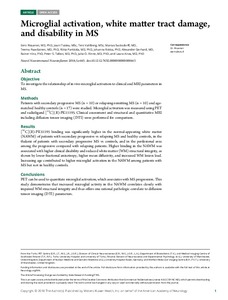Microglial activation, white matter tract damage, and disability in MS
Rissanen E; Tuisku J; Vahlberg T; Sucksdorff M; Paavilainen T; Parkkola R; Rokka J; Gerhard A; Hinz R; Talbot PS; Rinne JO; Airas L
Microglial activation, white matter tract damage, and disability in MS
Rissanen E
Tuisku J
Vahlberg T
Sucksdorff M
Paavilainen T
Parkkola R
Rokka J
Gerhard A
Hinz R
Talbot PS
Rinne JO
Airas L
LIPPINCOTT WILLIAMS & WILKINS
Julkaisun pysyvä osoite on:
https://urn.fi/URN:NBN:fi-fe2021042719448
https://urn.fi/URN:NBN:fi-fe2021042719448
Tiivistelmä
ObjectiveTo investigate the relationship of in vivo microglial activation to clinical and MRI parameters in MS.MethodsPatients with secondary progressive MS (n = 10) or relapsing-remitting MS (n = 10) and age-matched healthy controls (n = 17) were studied. Microglial activation was measured using PET and radioligand [C-11](R)-PK11195. Clinical assessment and structural and quantitative MRI including diffusion tensor imaging (DTI) were performed for comparison.Results[C-11](R)-PK11195 binding was significantly higher in the normal-appearing white matter (NAWM) of patients with secondary progressive vs relapsing MS and healthy controls, in the thalami of patients with secondary progressive MS vs controls, and in the perilesional area among the progressive compared with relapsing patients. Higher binding in the NAWM was associated with higher clinical disability and reduced white matter (WM) structural integrity, as shown by lower fractional anisotropy, higher mean diffusivity, and increased WM lesion load. Increasing age contributed to higher microglial activation in the NAWM among patients with MS but not in healthy controls.ConclusionsPET can be used to quantitate microglial activation, which associates with MS progression. This study demonstrates that increased microglial activity in the NAWM correlates closely with impaired WM structural integrity and thus offers one rational pathologic correlate to diffusion tensor imaging (DTI) parameters.
Kokoelmat
- Rinnakkaistallenteet [27094]
